Fossils are found in
- A) sedimentary rocks.
- B) igneous rocks.
- C) metamorphic rocks.
- D) glass.
A
What was the prevailing belief prior to the time of Lyell and Darwin?
- A) Earth is a few thousand years old, and populations are unchanging.
- B) Earth is a few thousand years old, and populations gradually change.
- C) Earth is millions of years old, and populations rapidly change.
- D) Earth is millions of years old, and populations are unchanging.
A
During a study session about evolution, one of your fellow students remarks, "The giraffe stretched its neck while reaching for higher leaves; its offspring inherited longer necks as a result." Which statement is most likely to be helpful in correcting this student's misconception?
- A) Characteristics acquired during an organism's life are generally not passed on through genes.
- B) Spontaneous mutations can result in the appearance of new traits.
- C) Only favorable adaptations have survival value.
- D) Disuse of an organ may lead to its eventual disappearance.
A
Which of the following is the most accurate summary of Cuvier's consideration of fossils found in the vicinity of Paris?
- A) extinction of species: yes; evolution of new species: yes
- B) extinction of species: no; evolution of new species: yes
- C) extinction of species: yes; evolution of new species: no
- D) extinction of species: no; evolution of new species: no
C
Lamarck's contribution to evolutionary theory was the
- A) use and disuse principle.
- B) idea of the inheritance of acquired characteristics.
- C) idea that evolutionary change explains patterns in fossils.
- D) idea that Earth's features could be explained by gradual mechanisms.
C
Charles Darwin was the first person to propose
- A) that evolution occurs.
- B) a mechanism for how evolution occurs.
- C) that Earth is older than a few thousand years.
- D) a mechanism for evolution that was supported by evidence.
D
What are adaptations?
- A) inherited characteristics of organisms that enhance their survival and reproduction in specific environments
- B) acquired characteristics of organisms that enhance their survival and reproduction in specific environments
- C) processes that allow individuals with certain inherited traits to survive and reproduce
- D) patterns seen in fossils documenting the origins of other new groups of organisms
A
Natural selection is based on all of the following except
- A) genetic variation exists within populations.
- B) the best-adapted individuals tend to leave the most offspring.
- C) individuals who survive longer tend to leave more offspring than those who die young.
- D) individuals adapt to their environments and thereby evolve.
D
Which of the following represents an idea that Darwin learned from the writings of Thomas Malthus?
- A) Technological innovation in agricultural practices will permit exponential growth of the human population into the foreseeable future.
- B) Populations tend to increase at a faster rate than their food supply normally allows.
- C) Earth changed over the years through a series of catastrophic upheavals.
- D) The environment is responsible for natural selection.
B
Given a population that contains genetic variation, what is the correct sequence of the following events, under the influence of natural selection?
- Well-adapted individuals leave more offspring than do poorly adapted individuals.
- A change occurs in the environment.
- Genetic frequencies within the population change.
- Poorly adapted individuals have decreased survivorship.
- A) 2 → 4 → 1 → 3
- B) 4 → 2 → 1 → 3
- C) 4 → 1 → 2 → 3
- D) 4 → 2 → 3 → 1
A
A biologist studied a population of squirrels for 15 years. During that time, the population was never fewer than 30 squirrels and never more than 45. Her data showed that over half of the squirrels born did not survive to reproduce, because of both competition for food and predation. In a single generation, 90% of the squirrels that were born lived to reproduce, and the population increased to 80. Which inference(s) about this population might be true?
- A) The amount of available food may have increased.
- B) The parental generation of squirrels developed better eyesight due to improved diet; the subsequent squirrel generation inherited better eyesight.
- C) The number of predators that prey upon squirrels may have decreased.
- D) Both A and C could be true.
D
Which of the following must exist in a population before natural selection can act upon that population?
- A) genetic variation among individuals
- B) variation among individuals caused by environmental factors
- C) sexual reproduction
- D) All of the above are correct.
A
Which of Darwin's ideas had the strongest connection to Darwin having read Malthus's essay on human population growth?
- A) descent with modification
- B) variation among individuals in a population
- C) the struggle for existence
- D) that the ancestors of the Galápagos finches had come from the South American mainland
C
Artificial selection is
- A) human-directed selective breeding.
- B) past extinction.
- C) patterns of evolution.
- D) slower than natural selection.
A
Darwin's observation of the Galápagos Islands finches' various beaks and behaviors could be explained by
- A) adaptations to the specific foods available on their mainland.
- B) adaptations forged by natural selection.
- C) modification with descent.
- D) inherited traits that did not survive.
B
DDT was once considered a "silver bullet" that would permanently eradicate insect pests. Instead, today DDT is largely useless against many insects. Which of the following should have occurred for this pest eradication effort to be successful in the long run?
- A) Larger doses of DDT should have been applied.
- B) All habitats should have received applications of DDT at about the same time.
- C) The frequency of DDT application should have been higher.
- D) None of the individual insects should have possessed genomes that made them resistant to DDT.
D
Analogous features share ________ function but not ________ ancestry.
- A) similar; common
- B) common; similar
- C) similar; similar
- D) common; common
A
Currently, two extant elephant species (X and Y) are placed in the genus Loxodonta, and a third species (Z) is placed in the genus Elephas. Thus, which of the following statements is true?
- A) Species X and Y are not related to species Z.
- B) Species X and Y share a greater number of homologies with each other than either does with species Z.
- C) Species X and Y share a common ancestor that is still extant (in other words, not yet extinct).
- D) Species X and Y are the result of artificial selection from an ancestral species Z.
B
The rise of methicillin-resistant Staphylococcus aureus (MRSA) can be considered to be an example of artificial selection because
- A) humans purposefully raise MRSA in large fermenters in an attempt to make the bacteria ever-more resistant.
- B) aureus is cultivated by humans to replenish the soil with nutrients.
- C) humans synthesize methicillin and create environments in which bacteria frequently come into contact with methicillin.
- D) Humans are becoming resistant to bacteria by taking methicillin.
C
Two plant species live in the same biome but on different continents. Although the two species are not at all closely related, they may appear quite similar as a result of
- A) parallel evolution.
- B) convergent evolution.
- C) allopatric speciation.
- D) gene flow.
B
If the bacterium Staphylococcus aureus experiences a cost for maintaining one or more antibiotic-resistance genes, then what should happen in environments from which antibiotics are missing?
- A) These genes should continue to be maintained in case the antibiotics ever appear.
- B) These bacteria should be outcompeted and replaced by bacteria that have lost these genes.
- C) The bacteria should try to make the cost worthwhile by locating, and migrating to, microenvironments where traces of antibiotics are present.
- D) The bacteria should start making and secreting their own antibiotics.
B
Of the following anatomical structures, which is homologous to the bones in the wing of a bird?
- A) bones in the hind limb of a kangaroo
- B) chitinous struts in the wing of a butterfly
- C) bony rays in the tail fin of a flying fish
- D) bones in the flipper of a whale
D
If two modern organisms are distantly related in an evolutionary sense, then one should expect that
- A) they live in very different habitats.
- B) they should share fewer homologous structures than two more closely related organisms.
- C) their chromosomes should be very similar.
- D) they shared a common ancestor relatively recently.
B
) What is an example of what happens when herbivores switch to a new food source with different characteristics?
- A) In southern Florida, the soapberry bug (Jadera haema-toloma) will not have beaks to feed on the seeds of a native plant, the balloon vine (Cardiospermum corindum).
- B) Soapberry bugs in central Florida, where balloon vines have become rare, now have bigger beaks to feed on seeds of the goldenrain tree (Koelreuteria elegans), a species recently introduced from Asia.
- C) Soapberry bugs feed most effectively when the length of their beak is longer than the depth at which seeds are found within the fruit. Goldenrain tree fruit consists of three flat lobes, and its seeds are much closer to the fruit surface than seeds of the plump, round fruit of the native balloon vine.
- D) In populations that feed on goldenrain tree, natural selection results in beaks that are shorter than those in populations that feed on balloon vine.
D
Over evolutionary time, many cave-dwelling organisms have lost their eyes. Tapeworms have lost their digestive systems. Whales have lost their hind limbs. How can natural selection account for these losses?
- A) Natural selection cannot account for losses, only for innovations.
- B) Natural selection accounts for these losses by the principle of use and disuse.
- C) Under particular circumstances that persisted for long periods, each of these structures presented greater costs than benefits.
- D) The ancestors of these organisms experienced harmful mutations that forced them to find new habitats that these species had not previously used.
C
Which of the following pieces of evidence most strongly supports the common origin of all life on Earth?
- A) All organisms require energy.
- B) All organisms use essentially the same genetic code.
- C) All organisms reproduce.
- D) All organisms show heritable variation.
B
Members of two different species possess similar-looking structures that they use in a similar fashion to perform the same function. Which of the following statements describes these structures originating from convergent evolution?
- A) The two species live at great distance from each other and have structures for flying.
- B) These structures share function but do not share a common ancestry.
- C) The functions of the structures in adult members of both species are not similar.
- D) Both species have structures that are not adapted to their particular environments.
B
logically, which of the following should cast the most doubt on the relationships depicted by an evolutionary tree?
- A) Some of the organisms depicted by the tree had lived in different habitats.
- B) The skeletal remains of the organisms depicted by the tree were incomplete (in other words, some bones were missing).
- C) Transitional fossils had not been found.
- D) Relationships between DNA sequences among the species did not match relationships between skeletal patterns.
D
Which of the following statements indicate the function of the appendix?
- A) The appendix can be surgically removed with no immediate ill effects.
- B) The appendix might have been larger in fossil hominids.
- C) The appendix has a substantial amount of defensive lymphatic tissue.
- D) Individuals with a larger-than-average appendix leave fewer offspring than those with a below-average-sized appendix.
C
What environment stimulates evolution of drug-resistant pathogens?
- A) presence of an enzyme called penicillinase
- B) colonization of host
- C) pathogens without cell walls
- D) excess antibiotics
A
Both ancestral birds and ancestral mammals shared a common ancestor that was terrestrial. Today, penguins (which are birds) and seals (which are mammals) have forelimbs adapted for swimming. What term best describes the relationship of the bones in the forelimbs of penguins and seals, and what term best describes the flippers of penguins and seals?
- A) homologous; homologous
- B) analogous; homologous
- C) homologous; analogous
- D) analogous; analogous
C
What must be true of any organ that is described as vestigial?
- A) It must be analogous to some feature in an ancestor.
- B) It must be homologous to some feature in an ancestor.
- C) It must be both homologous and analogous to some feature in an ancestor.
- D) It need be neither homologous nor analogous to some feature in an ancestor.
B
What is true of pseudogenes?
- A) They are composed of RNA, rather than DNA.
- B) They are the same things as introns.
- C) They are unrelated genes that code for the same gene product.
- D) They are vestigial genes.
D
It has been observed that organisms on islands are different from, but closely related to, similar forms found on the nearest continent. This is taken as evidence that
- A) island forms and mainland forms descended from common ancestors.
- B) common environments are inhabited by the same organisms.
- C) the islands were originally part of the continent.
- D) the island forms and mainland forms are converging.
A
If one wanted to find the largest number of endemic species, one should visit which of the following geological features (assuming each has existed for several millions of years)?
- A) an isolated ocean island in the tropics
- B) an extensive mountain range
- C) a midcontinental grassland with extreme climatic conditions
- D) a shallow estuary on a warm-water coast
A
Convergent evolution uses analogous features to describe
- A) distantly related organisms that have structures for a different functions.
- B) the independent evolution of similar features in different lineages.
- C) two mammals that have adapted to similar environments in similar way.
- D) features that share common ancestry but not necessarily similar function.
D
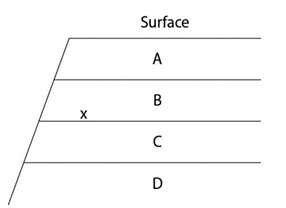
Figure 19.1 shows an outcrop of sedimentary rock whose strata are labeled A-D. If x indicates the location of fossils of two closely related species, then fossils of their most-recent common ancestor are most likely to occur in which stratum?
- A) A
- B) B
- C) C
- D) D
C
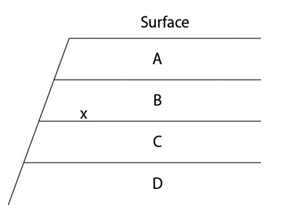
Figure 19.1 shows an outcrop of sedimentary rock whose strata are labeled A-D. If x indicates the fossils of two closely related species, neither of which is extinct, then their remains may be found in how many of these strata?
- A) one stratum
- B) two strata
- C) three strata
- D) four strata
B
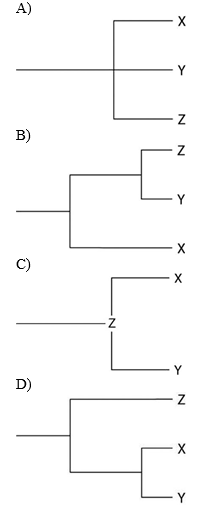
Currently, two extant elephant species (X and Y) are placed in the genus Loxodonta, and a third species (Z) is placed in the genus Elephas. Assuming this classification reflects evolutionary relatedness, which of the following is the most accurate phylogenetic tree?
A)
B)
C)
D)
D
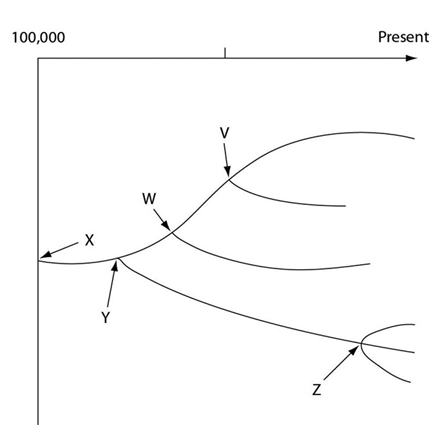
Which pair would probably have agreed with the process that is depicted by this tree?
- A) Cuvier and Lamarck
- B) Lamarck and Wallace
- C) Aristotle and Lyell
- D) Wallace and Linnaeus
B
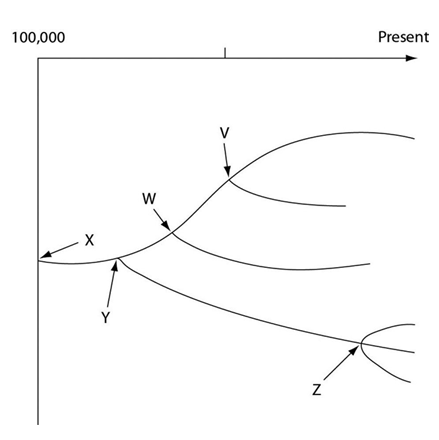
How many separate species, both extant and extinct, are depicted in this tree?
- A) two
- B) four
- C) five
- D) six
D
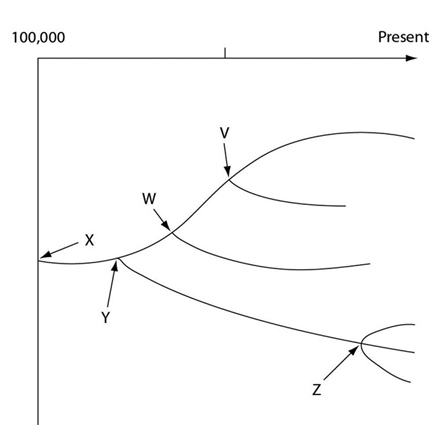
According to this tree, what percent of the species seem to be extant (in other words, not extinct)?
- A) 25%
- B) 33%
- C) 50%
- D) 66%
D
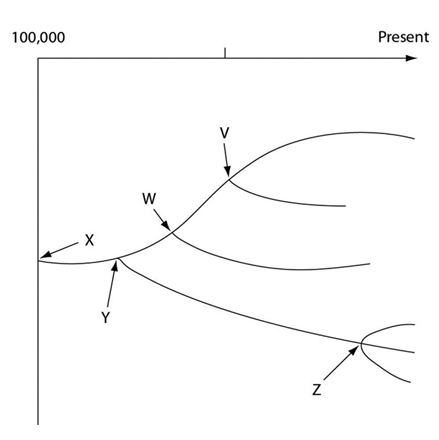
Which of the five common ancestors, labeled V-Z, has given rise to the greatest number of species, both extant and extinct?
- A) V
- B) W
- C) Both W and Z can be considered to have given rise to the greatest number of extant and extinct species.
- D) Both X and Y can be considered to have given rise to the greatest number of extant and extinct species.
D
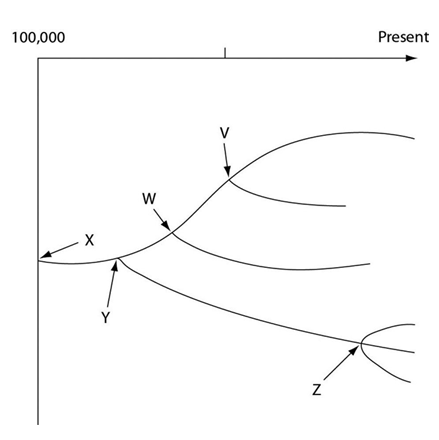
Which of the five common ancestors, labeled V-Z, has been least successful in terms of the percent of its derived species that are extant?
- A) V
- B) W
- C) X
- D) Y
B
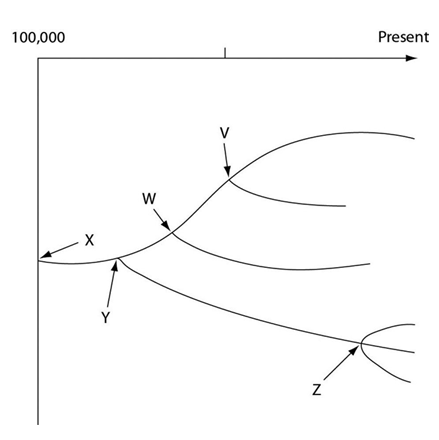
Which of the five common ancestors, labeled V-Z, has been most successful in terms of the percent of its derived species that are extant?
- A) V
- B) W
- C) X
- D) Z
D
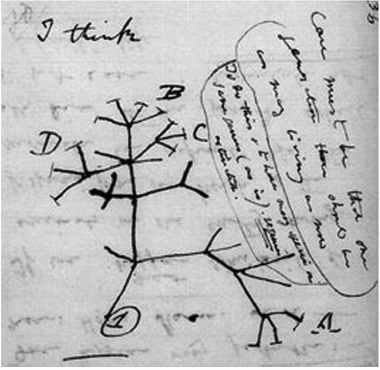
Darwin viewed the history of life as a tree, with multiple branchings from a common trunk to the tips of the twigs. Which part of that tree represents extant organisms?
- A) tips of the twigs
- B) unlabeled branches
- C) common trunk
- D) forks of the tree
A
If the six ground finch species have evolved most recently, then which of these is the most logical prediction?
- A) They should be limited to the six islands that most recently emerged from the sea.
- B) Their genomes should be more similar to each other than are the genomes of the five tree finch species.
- C) They should share fewer anatomical homologies with each other than they share with the tree finches.
- D) The chances of hybridization between two ground finch species should be less than the chances of hybridization between two tree finch species.
B
According to a 1999 study, the vegetarian finch is genetically no more similar to the tree finch than it is to the ground finch, despite the fact that it is placed in the same genus as the tree finch. Based on this finding, it is reasonable to conclude that the vegetarian finch
- A) is no more closely related to the tree finch than it is to the ground finch, despite its classification.
- B) should be reclassified as a warbler finch.
- C) is not truly a descendent of the original ancestral finch.
- D) is a hybrid species, resulting from a cross between a ground finch and a tree finch.
A
An article in the New York Times stated the following: "Scientists have discovered micro-organisms living beneath the ocean floor that appear to have not evolved for more than two billion years, a finding that nonetheless may support the theory of evolution." The lack of evolution of these microorganisms could be caused by
- A) organisms adapting to a changing physical or biological environment.
- B) the bacteria's unchanging environment.
- C) lack of protection in an environment that's existed on Earth, unchanged.
- D) comparison of the specimens to modern communities of sulfur bacteria.
B
An article in the New York Times noted that the human population has shown a significant increase in height. When the relationship of height to reproductive success in humans was examined across three decades (1935-1967), height had a positive correlation to the number of children born and the number of surviving children. These observations suggest that
- A) individuals vary in heritable characteristics.
- B) humans produce more offspring than the environment can support.
- C) individuals who are taller are better suited to their environment.
- D) over time, favorable traits will accumulate in the population.
D
Which of the following is not an observation or inference on which natural selection is based?
- A) There is heritable variation among individuals.
- B) Poorly adapted individuals never produce offspring.
- C) Species produce more offspring than the environment can support.
- D) Only a fraction of an individual's offspring may survive.
B
Which of the following observations helped Darwin shape his concept of descent with modification?
- A) Species diversity declines farther from the equator.
- B) Fewer species live on islands than on the nearest continents.
- C) Birds live on islands located farther from the mainland than the birds' maximum nonstop flight distance.
- D) South American temperate plants are more similar to the tropical plants of South America than to the temperate plants of Europe.
D
Within six months of effectively using methicillin to treat S. aureus infections in a community, all new S. aureus infections were caused by MRSA. How can this best be explained?
- A) A patient must have become infected with MRSA from another community.
- B) In response to the drug, aureus began making drug-resistant versions of the protein targeted by the drug.
- C) Some drug-resistant bacteria were present at the start of treatment, and natural selection increased their frequency.
- D) aureus evolved to resist vaccines.
C
The upper forelimbs of humans and bats have fairly similar skeletal structures, whereas the corresponding bones in whales have very different shapes and proportions. However, genetic data suggest that all three kinds of organisms diverged from a common ancestor at about the same time. Which of the following is the most likely explanation for these data?
- A) Forelimb evolution was adaptive in people and bats, but not in whales.
- B) Natural selection in an aquatic environment resulted in significant changes to whale forelimb anatomy.
- C) Genes mutate faster in whales than in humans or bats.
- D) Whales are not properly classified as mammals.
B
DNA sequences in many human genes are very similar to the sequences of corresponding genes in chimpanzees. The most likely explanation for this result is that
- A) humans and chimpanzees share a relatively recent common ancestor.
- B) humans evolved from chimpanzees.
- C) chimpanzees evolved from humans.
- D) convergent evolution led to the DNA similarities.
A